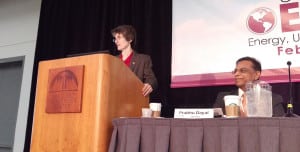EPA, DOE Experts Upbeat on Regulatory Agenda
The Environmental Protection Agency’s (EPA’s) acting administrator of the Office of Air and Radiation, and the Department of Energy’s (DOE’s) head of clean coal and carbon management gave upbeat assessments of the Obama administration’s regulatory agenda and power sector priorities speaking at the EUEC 2016 conference in San Diego on February 3.
Janet McCabe of the EPA began by asserting that the agency has made a concerted effort to connect and communicate with the industries it regulates.

“We’ve gotten more collaborative. We talk to each other and communicate,” she said. “We can’t fix these things without all of us working together.”
McCabe reviewed the numerous regulatory initiatives the EPA has been advancing in the past few years. She began by noting that in 2014, 57 million people in the U.S. lived in counties that were in noncompliance with at least one air quality standard.
Clean Power Plan
With respect to the Clean Power Plan (CPP), 2016 will bring several milestones. This September is the deadline for states to submit a state implementation plan (SIP) or request an extension. Despite the opposition, McCabe said that, ultimately, “We expect that pretty much every state will want to do their own plan.”
The EPA will finalize the model rules and the incentive program for states that want to go beyond the CPP this year. She said the EPA will release a proposal for the incentive plan without a lot of the mechanics for compliance because the agency is expecting a lot of comments on it.
She also noted that every regional EPA office has been working to field questions and assist states in developing SIPs—this despite the ongoing litigation.
On that issue, McCabe noted the “extremely expeditious” manner in which the D.C. Circuit is handling the challenges, with briefing due much more quickly than usual.
She would not speculate on the outcome, but said, “It’s critical that we continue to work with the states. This is not the first time an EPA rule has been challenged. The courts will address it, but in the meantime, we will continue to work.”
CSAPR, MATS, and Ozone
McCabe then turned to the Cross-State Air Pollution Rule (CSAPR), which survived a Supreme Court review in 2014.
“I was very pleased about this,” McCabe said. When it comes to state-level implementation of these rules, “EPA needs to be there” to help make it happen.
The current CSAPR update process is implementing the 2008 National Ambient Air Quality Standards (NAAQS) for ozone. The final rule should be out this summer.
McCabe was also confident about the survival of the Mercury and Air Toxics Standards (MATS), despite the Supreme Court sending the EPA back to the drawing board last fall.
The EPA is completing the requested reassessment, and it is arguing that costs do not affect the final conclusion.
“The court held that we had considered costs at the wrong point in the process. We certainly had considered costs.”
Most plants are already in compliance, she noted.
On the new rule for ground-level ozone under NAAQS, McCabe briefly addressed concerns about background ozone, which exists because of natural environmental factors. She said it did not factor into where the EPA set the standard, but, “We do think it’s an issue of great interest” and the EPA will consider it going forward.
Don’t Lose Faith in CCUS
David Mohler, the DOE’s deputy assistant secretary for clean coal and carbon management, began by noting that fossil fuels would remain a key element of the power mix no matter the progress on decarbonization or international commitments for carbon reductions such as the recent Paris accords.
“How do we use the energy resources at our disposal in a way that’s cheap, clean, and efficient?” he asked.
Mohler said that U.S. coal, oil, and gas consumption are still projected to grow through 2030. That’s why carbon capture, utilization, and storage (CCUS) will be critical. “Even with very significant efficiency increases, CCUS is still needed,” he said.
He argued that the biggest challenge with CCUS is not the cost or technology, both of which have seen improvements, but the financing—making it economic. “The question is, how do you finance it?”
Slow Progress
Mohler defended CCUS from criticism directed at the slow pace in getting projects online: “I challenge anyone to anticipate everything that’s going to happen with a new technology.”
SaskPower’s Boundary Dam project in Canada, POWER’s 2015 Plant of the Year, despite some hiccups, is a “very interesting and, in my mind, successful project,” he said. Mississippi Power’s Kemper County project, despite repeated setbacks of its own, is nearing completion.
Mohler singled out NRG Energy’s W.A. Parish plant for special praise. NRG’s approach in leveraging carbon capture for enhanced oil recovery in an oil field NRG owns makes for an “elegant business model solution” that “gets away from traditional regulated utility” approaches.
He did concede that CCUS is a “tough sell” without creative business models.
Getting back to the question of financing, Mohler noted that policy support is critical at the moment. Tax credits for carbon storage are one possible approach.
“At $30 to $40 a ton [for CO2], CCUS starts to look attractive,” he said. “But if the policy support isn’t there, the technology support becomes more problematic.”
Finally, Mohler exhorted the audience to pay attention to developments in China, where the future of CCUS may be unfolding. Because of China’s massive investments in CCUS and clean coal capacity, “we can only learn from them.”
China has little choice, he said. Serious problems with pollution “have driven China to think about all aspects of air quality. So China is very serious about CCUS.”
—Thomas W. Overton, JD is a POWER associate editor (@thomas_overton, @POWERmagazine).